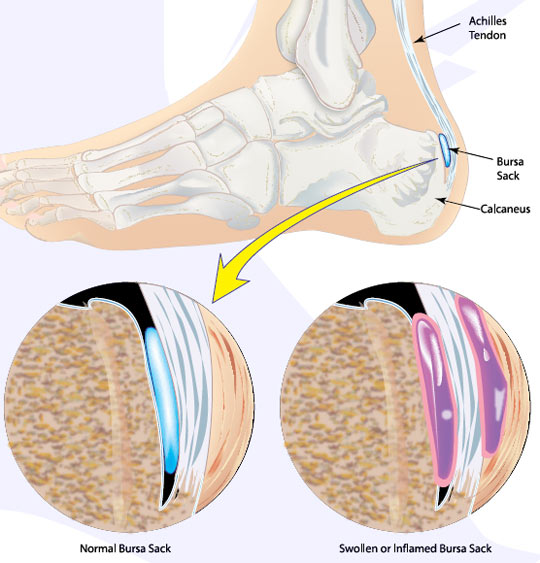Achilles Bursitis

Achilles bursitis, also known as retrocalcaneal bursitis, is a common condition in athletes. A bursa is a small sack of fluid that goes between a tendon and a bone to help the tendon move smoothly over the bone. The retrocalcaneal bursa lies between the Achilles tendon and the calcaneus (heel bone). With repeated trauma the bursa can become inflamed. It can often be mistaken for Achilles tendonitis. When a patient has Achilles tendonitis and Achilles bursitis at the same time, it is known as Haglund's syndrome.
What Causes Achilles Bursitis?
The major cause of Achilles bursitis is overuse, most likely from too much walking, running or jumping. It's no wonder that Achilles bursitis is especially common in athletes. A sudden increase in activity level without proper conditioning can increase a patient's risk for Achilles bursitis.
Achilles Bursitis Symptoms
The most common symptom of Achilles bursitis is pain at the back of the heel, especially when running uphill or on soft surfaces such as sand. Pain may get worse when standing on tiptoes. The area may also feel tender when touched, and some patients report that the heel may feel "spongy". Some swelling may also be observed.
Achilles Bursitis Treatment
As with any injury, your doctor will be the best source of advice on the appropriate treatment method for your situation. However, there are a variety of methods that you can try at home to see if there is any improvement if your injury is not severe.
Steps to Achilles Bursitis Management
Step 1
Rest the foot. Stop all activities that cause pain for 1-2 weeks.
Step 2
Apply ice. Cold therapy can help alleviate pain and swelling. Apply ice over the painful area for 10 minutes on and 10 minutes off, two to three times a day. Make sure you do not apply ice directly to the skin as that may cause frostburn.
Step 3
Take an anti-inflammatory such as ibuprofen or aspirin to help reduce inflammation and pain.
Step 4
Relieve pressure on the achilles with a heel support when walking. DonJoy Silicone Heel Cups helps take the pressure off the achilles when walking and may provide comfort.
Symptoms typically resolve within 2-3 weeks. When starting exercise again, begin very gradually as to not re-aggravate the previous injury. Start with walking and graduate to jogging, running and lastly, jumping and sprinting. Make sure to tone down if you feel any pain.
If these steps do not help alleviate symptoms of Achilles bursitis, a physician may use a steroid injection to reduce inflammation in the retrocalcaneal bursa. This is followed up by rest, as the bursa may rupture, especially if the injection is given more than once. The doctor may also place the foot in a cast, especially if the patient has Achilles bursitis in conjunction with Achilles tendonitis. In rare cases, surgery may be needed to remove the affected bursa.
SUPPORT & PROTECTION FOR ACHILLES BURSITIS
-
 $42.01On Sale 0% Off Save $0.00(3) ReviewsCushion every step with ProCare® Silicone Heel Cups — designed for shock absorption and heel pain relief. Perfect for plantar fasciitis, heel spurs, and daily comfort, they reduce pressure and improve foot stability. Step pain-free and supported with trusted orthopedic heel protection.
$42.01On Sale 0% Off Save $0.00(3) ReviewsCushion every step with ProCare® Silicone Heel Cups — designed for shock absorption and heel pain relief. Perfect for plantar fasciitis, heel spurs, and daily comfort, they reduce pressure and improve foot stability. Step pain-free and supported with trusted orthopedic heel protection.












